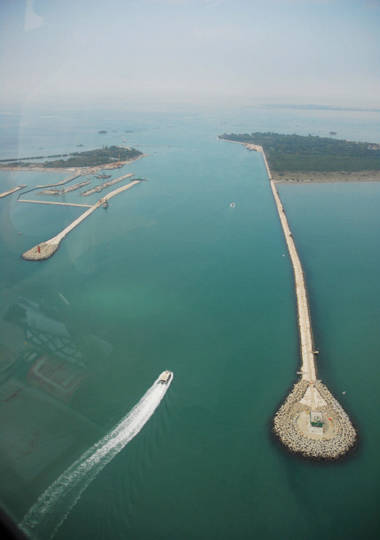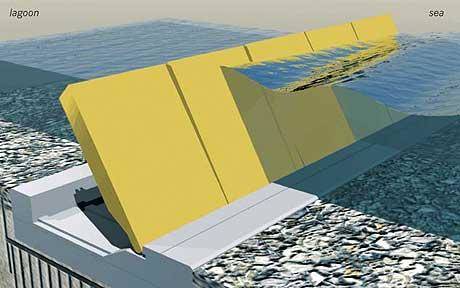How Italian Technology is Trying to Save Venice. The MOSE Project Presented in New York
It is widely accepted that without human intervention, Venice would eventually be abandoned to the tides. The MOSE will temporarily separate the lagoon from the sea. How will it work and why is this—according to you—the right answer to Venice's flooding problems?
Yes it is, the Venice Lagoon survived to nowadays thanks to a series of interventions during the centuries (as the diversions of the rivers in order to avoid the silting up of the lagoon).
The objective of the Italian legislation to safeguard Venice is to guarantee the complete defence of all areas in the lagoon from high waters of all levels, including extreme events. Ever more frequently, Venice, Chioggia, and other historic towns and villages in the lagoon are flooded, and the lowest lying zones - usually the oldest and most valuable - are flooded almost daily, particularly during the winter. The risk of an event representing a danger to the city, such as that of 1966, is ever greater.
The Mose system includes mobile flood barriers (realized at the lagoon inlets in order to isolate temporarily the lagoon from the sea during the high water events) and local defences, carried out by “raising up” the lagoon banks and public pavement in the lowest areas of the city. The mobile flood barriers are made up of rows of flap-gates built into the inlet canal beds. They are "mobile" in so far as during normal tide conditions they are full of water and lie flat in their housings built into the inlet canal bed. When tides exceeding safeguarding level are forecast, an emission of compressed air empties the flap-gates of water until they emerge. In this way, it is possible to temporarily isolate the lagoon from the sea thereby blocking the flow of the tide. The inlets remain closed both for the duration of the high water and for the time it takes to manoeuvre the flap-gates (on an average a total of 4.5 hours).
The gate-opening manoeuvres follow precise procedures, taking into account the possible increase of water in the lagoon due to input from rivers, rain, local rises caused by wind, and/or the passage of water between one gate and the next. The Mose can protect the lagoon and the urban centres from a tide level of about 10 feet and with a sea level rise of 2 feet.
Management of Mose is flexible enough to cope with an increase in high waters in various ways, depending on the characteristics and scale of the tidal event. Depending on the situation, the defence strategies can involve simultaneous closure of all three inlets in case t of an exceptional event or alternatively and according to the winds, pressure and amplitude of the forecast tide, differentiated closure of the inlets, or again, partial closure of each inlet, as the gates are all independent.
The integration between the mobile barriers and the raising up of the banks and pavements defines a system of defence that is extremely efficient and functional, and that not only guarantees the total defence from high waters, but also guarantees port activity, water quality, and the safeguarding of the lagoon environment. This is a vital environmental program being undertaken by the government as a response to the body of special legislation introduced to
safeguard Venice and its lagoon.
MOSE is the product of long and detailed studies carried out by private companies and research institutes in Italy and around the world. The technology however is essentially Italian. Who are the main scientific-technological actors behind MOSE?
For many years now, the Consorzio Venezia Nuova on behalf of the Ministry of Infrastructure - Venice Water Authority has been implementing an extensive system of measures throughout the Venice lagoon area, designed to provide complete protection from flooding and sea storms and safeguard the ecosystem.
Since it was set up, Consorzio Venezia Nuova has carried out extensive studies and experiments aimed both at understanding the phenomena and processes affecting the ecosystem of the lagoon, and at planning projects and implementing real protective measures, involving many Italian and foreign universities and research centres. It avails itself also of many American experts from the M.I.T. university in Boston, the SCRIPPS Institute of San Diego, the University of California and, since 2006, it has taken part in an international network for Storm Surge Barrier Managers, done by Dutch, English, Russian, and Italian Countries. The goal of the international network is exchanging and sharing experiences and the transfer of knowledge on operational and functional management of large movable storm surge barriers in order to optimize the management of barriers by innovative technology. In this network public administrations co-operate and collaborate on issues of common interest, forming a community of practice.
What is the relationship between private bodies and state institutions in the work of projecting and realizing MOSE?
Playing the leading role in safeguarding Venice, each within their particular area of responsibility, are the Italian State (measures to physically safeguard the lagoon and restore hydrogeological balance), the Veneto Region (abatement of water pollution), and the Venice and Chioggia local authorities (urban restoration and maintenance and measures to promote and encourage socio-economic development). The body responsible for policy, coordination and control of the objectives established by the special legislation is the Committee as per art. 4 of Law no. 798/84 (the "Comitatone"), which is composed of the competent ministers (Infrastructure and Transport, Environment and Territorial Protection, Cultural Heritage and Activities, University Education and Scientific Research), the Chairman of the Water Authority, the Chairman of the Veneto Regional Authority, the mayors of Venice and Chioggia, Treporti-Cavallino Local Authority, and two representatives of the other local authorities along the lagoon boundary. It is chaired by the President of the Council of Ministers.
Because the complexity of the Venice problem, the “reciprocity” of every action in the lagoon environment and the highly experimental nature of the safeguarding interventions delegated to the State require the preparation and implementation of an “integrated plan” of interventions to tackle the various aspects of the physical and environmental safeguarding of the lagoon ecosystem in a unitary and organic fashion and with a systematic approach. Special Law no. 798/84 thus established that the State administration could nominate a single body to take on responsibility for the interventions as a whole.
To carry out the measures aimed at safeguarding Venice and its lagoon in accordance with Law n. 798 of 1984, the Venice Water Authority avails itself, like its concessionaire, of the Consorzio Venezia Nuova. It consists of a group of leading Italian construction companies of international importance and local cooperatives and firms with considerable experience of operating in the lagoon. The Consortium acts, of course, under the direct control of the Venice Water Authority and on the basis of a general plan of interventions defined and approved by the “Comitatone” (and therefore by the institutions represented on the committee) and by Parliament which, in Special Law no. 139/92, adopted it as a reference for the development and financing of interventions programmed, implemented and underway.
Consorzio Venezia Nuova has developed a structure able to plan, organise, manage and control the safeguarding measures during the various phases of implementation, while at the same time acting as the operational interface between the granting administration (the Venice Water Authority) on one hand and those carrying out the work on the other (designers, experts responsible for studies and experiments and companies carrying out the work).
Why is MOSE so controversial in Italy and especially in Venice? Many say that it is “surgery before medicine” and that less radical, softer measures should be tried first that would avoid the environmental disruption and skyrocketing costs that MOSE seems to bring with it.
Well, it was controversial in Venice, like any big project is and not only in Venice or in Italy!
The opposition was more noisy than substantial: the majority of Venetians was, and it is, in favour of the Mose project. If a few years ago, the Mose project was defined as too “huge” and not necessary by the opposition, now the same people say that it is not sufficient, and that Venice will need something bigger! The Mose project is the best solution for solving the problems of high water now and in the future, in presence of a bad sea level rise, as well. It is an important measure for the lagoon environment, not against it.
Nothwithstanding its uniqueness, Venice faces challenges that have some similarities with those affecting other cities: London and Rotterdam, in Europe; New Orleans in the U.S. The international conference under preparation in New York is entitled “Saving Venezia, Protecting New Orleans”. To what extent and in what ways could MO.S.E.’s approach and know-how offer useful suggestions for these other cities?
Consorzio Venezia Nuova is part of the International Network, that is a great unique opportunity for each country for building effective parternships, for sharing organizational aspects, for improving the current management, for exchanging products, services and for innovating services and competencies.
Find the full program of the conference on ILICA's website








































i-Italy
Facebook
Google+
This work may not be reproduced, in whole or in part, without prior written permission.
Questo lavoro non può essere riprodotto, in tutto o in parte, senza permesso scritto.